1 Suppose you used Ordinary Least Squares OLS to estimate th
1.
Suppose you used Ordinary Least Squares (OLS) to estimate the following model (the subscripts i have been dropped throughout):
Where StartingSalary is a recent graduate’s starting salary in dollars, GPA is their cumulative grade point average, Male = 1 if the person is a male and Male = 0 if the person is a Female and Business = 1 if the person graduated from the College of Business and Business = 0 if the person did not graduate from the College of Business.
Which of the following is true?
Select one:
a. StartingSalary is an independent variable
b. the disturbance term (error term) captures the effect of GPA on starting salary
c. Male and Business are both dummy variables
d. GPA is a dummy variable
2. Refer to the information from Question 1:
Using the Excel output obtained from running the OLS regression, suppose you formed the following: StartingSalary = $25,000 + $2,000GPA + $1,700Male + $4,500Business .
Given this sample regression function, which of the following is true?
Select one:
a. We predict that males will earn $1,700 more than females in starting salary amounts.
b. We predict that males will earn $26,700 more than females in starting salary amounts.
c. We predict a one unit increase in Male causes a $1,700 increase in starting salary.
d. We predict Business majors to earn lower starting salaries compared to non-Business majors
3. Using the sample regression function given in Question 2, predict the starting salary for a recent male graduate with a GPA = 3.00 and a major in English.
Select one:
a. $32,560
b. $38,760
c. $41,230
d. $32,700
4. Suppose from Question 2 that the standard error for the parameter estimate for GPA is sb1 = 1,500.
Calculate the test statistic for the following hypothesis test:
H0: ?1 = 0
HA: ?1 ? 0
Select one:
a. t = 2.14
b. t = 1.33
c. t = 0.87
d. t = 2.84
5.
If I wanted to determine how well my sample regression function “fit” the actual data, I would
Select one:
a. do a hypotheses tests on each individual coefficient
b. calculate r2
c. do a hypothesis test on GPA
d. minimize the sum of the squared deviations
6.
Figure 1 shows Excel output estimating the following model:
Salary= ?0 + ?1Male + ?2Experience + ?3Over50 + ?4MBA + ?
Where, Salary = a person’s salary in thousands of dollars, Male = 1 if the person is a male (0 otherwise), Experience = number of years experience, Over50 = 1 if the person is over 50 (0 otherwise) and MBA =1 if the person has an MBA (0 otherwise).
Which coefficient(s) is(are) significant at the .05 level?
Select one:
a. All of them
b. Male, Over50 and MBA
c. Over50 and Experience
d. Experience
7.
Refer to Figure 1
Which of the following is the correct interpretation?
Select one:
a. An increase in experience of 1 year, results in an increase in the predicted salary of around $3,000.
b. A $3,000 increase in experience results in a 1 unit increase in salary.
c. Males earn around $2,000 more than Females for every additional year of experience they have.
d. MBAs make less money than non MBAs.
8.
To test whether the regression equation is significant at the .05 level, which of the following contains the correct Null and Alternative Hypotheses.
Select one:
a. H0: ?3 = 0; HA: ?3 ? 0
b. H0: ?2 = 0; HA: ?2 ? 0
c. H0: ?1 = ?2 = ?3 = ?4 = 0; HA: At least one of the coefficients is not zero
d. H0: ?1 = ?2 = ?3 = ?4 = 0; HA: ?1 ? ?2 ? ?3 ? ?4 ? 0
9.
Refer to Figure 1
What percentage of the variation in salaries is explained by the regression equation?
Select one:
a. 91.3%
b. 76.5%
c. 85.6%
d. 42.3%
10.
What is the total variation in salaries?
Select one:
a. 12,771
b. 1,108
c. 11,663
d. 55.41
11. Ordinary Least Squares (OLS) produces coefficient estimates by
Select one:
a. maximizing SSE
b. minimizing SSE
c. maximizing SST
d. minimizing SSR
12.
Figure 2 shows Excel output estimating the following model:
NumBikeThefts= ?0 + ?1Income + ?2Unem + ?3Pupil/Tea + ?4Divorce + ?
Where, NumBikeThefts = the number of bikes stolen per state, Income = per capita income per state in dollars, Unem = % of population unemployed by state, Pupil/Tea = the ratio of students to teachers by state, and Divorce = the divorce rate by state.
Which coefficient(s) is (are) significant at the .025 level?
Select one:
a. Income, Unemployment and Pupil/Tea
b. Divorce
c. Income and Pupil/Tea
d. Income
13.
Refer to Figure 2
Is the regression equation significant at the .05 level?
Select one:
a. YES
b. NO
c. Need more information to answer this question
14.
Refer to Figure 2
Which of the following is a correct interpretation for the variable Income?
Select one:
a. A 1 dollar increase in per capita income results in fewer bike thefts.
b. Per capita income does not significantly affect the number of bike thefts at the .05 level.
c. A 1 dollar increase in per capita income results in the predicted number of bike thefts to increase by 0.02.
d. An increase in per capita income of $1,000 results in the predicted number of bike thefts to increase by 2.
15.
Refer to Figure 2
What is the predicted number of bike thefts in a state with a per capita income of $25,000, an unemployment rate of 8% (enter in “8”), a pupil teacher ratio of 20 and a divorce rate of 1% (enter in “1”)? Round to 4 decimal places when making the calculations.
Select one:
a. 267
b. 321
c. 582
d. 496
16.
With different samples, our parameter estimates (b’s) will vary. However, on average, what should bi equal?
Select one:
a. 0
b. SST
c. r2
d. ?i
e. ?
17.
A dataset that is homoskedastic has which of the following properties?
Select one:
a. The disturbances are normally distributed
b. The variation in the disturbance term is constant overall all the values for the independent variable(s).
c. The regression line “fits” the data perfectly.
d. The dependent variable decreases with increase in the independent variable.
18.
Figure 3 shows Excel output estimating the following model:
MPG = ?0 + ?1Length + ?2Width + ?3Weight + ?4Japan+ ?
Where, MPG = miles per gallon, Length = length of the vehicle in inches, Width = width of the vehicle in inches, Weight = weight of the vehicle in pounds and Japan = dummy variable that is 1 if the vehicle was made in Japan and 0 if it was not made in Japan.
What is the lowest level of significance for which you would reject the null hypothesis that the variable Japan has no effect on MPG?
Select one:
a. 0.12
b. 0.05
c. 0.01
d. 0.20
19.
Refer to Figure 3
Interpret the effect of Weight on MPG?
Select one:
a. A 1 pound increase in a vehicle’s weight, causes the predicted miles per gallon to drop by 0.0041 miles.
b. A 0.0041 pound decrease in weight causes a 1 mile increase in miles per gallon.
c. Vehicles that have weight get 0.0041 miles per gallon less than vehicles that do not have weight.
d. A .41% increase in a vehicles weight, causes the predicted miles per gallon to decrease by 1 mile.
20.
Using the sample estimate b1, from Figure 3 what can we conclude about the value of the population parameter ?1?
Select one:
a. ?1 is significantly different from zero at the .05 level
b. ?1 is not significantly different from zero at the .05 level
c. ?1 is significantly different from zero at the .25 level
d. both b. and c. are correct
21.
Suppose you used Ordinary Least Squares (OLS) to estimate the effect ticket price (in dollars) has on the number of skiers at Appalachian Ski Mountain.
Which of the following is true?
Select one:
a. number of skiers is a dependent and endogenous variable
b. ticket price is endogenous
c. ticket price is an exogenous and dependent variable
d. ticket price is a dummy variable
e. both a and b are correct
22.
Using the Excel output obtained from running the OLS regression, suppose you formed the following: NumberSkiers = 400 – 2.5TicketPrice .
Given this sample regression function, predict the number of skiers at Appalachian Ski Mountain with a ticket price of $45.
Select one:
a. 200
b. 288
c. 198
d. 513
23.
Figure 4 shows Excel output estimating the following model:
HousingPrice = ?0 + ?1SqFeet + ?2LotSize + ?3Baths + ?4BathSinks + ?
Where, HousingPrice = the price of a home in thousands of dollars, SqFeet = square footage of the home, Lotsize = size of the lot in thousand square feet, Baths = number of bathrooms and BathSinks = number of bathroom sinks.
Which of the independent variables show signs of high correlation with one or more of the other independent variables (i.e., high multicolinearity)?
Select one:
a. Square Feet
b. Lot Size
c. Square Feet and Lot Size
d. Baths and BathSinks
e. BathSinks
24.
One of the problems resulting from highly correlated independent variables (multicolinearity) is:
Select one:
a. Deflated (low) standard errors on the coefficient estimates.
b. The p-values for the coefficient estimates are deflated (low).
c. The test statistics for the coefficient estimates will be deflated (low).
d. The overall fit of the model (r2) will be negatively affected.
25.
Suppose you used Excel to estimate the following model:
ATMTime= ?0 + ?1Age+ ?2Gender+ ?
Where, ATMTime = time it takes to complete an ATM transaction in seconds, Age = age of the customer in years, Gender = dummy variable that is 1 if the customer is male and 0 if the customer is female.
Suppose the 95% confidence interval around the parameter estimate for ?1 was calculated and had lower limit of 0.025 and an upper limit of 0.500.
Does Age significantly affect ATMTime at the 0.025 significance level?
Select one:
a. Yes
b. No
c. More information is required to answer this question
StartingSalary = 0.pGPA+ 2Male+ , Business + A )Solution
a. StartingSalary is an independent variable
a. We predict that males will earn $1,700 more than females in starting salary amounts.
d. $32,700
for the other question
I can gladly help you but you should post it in a new question
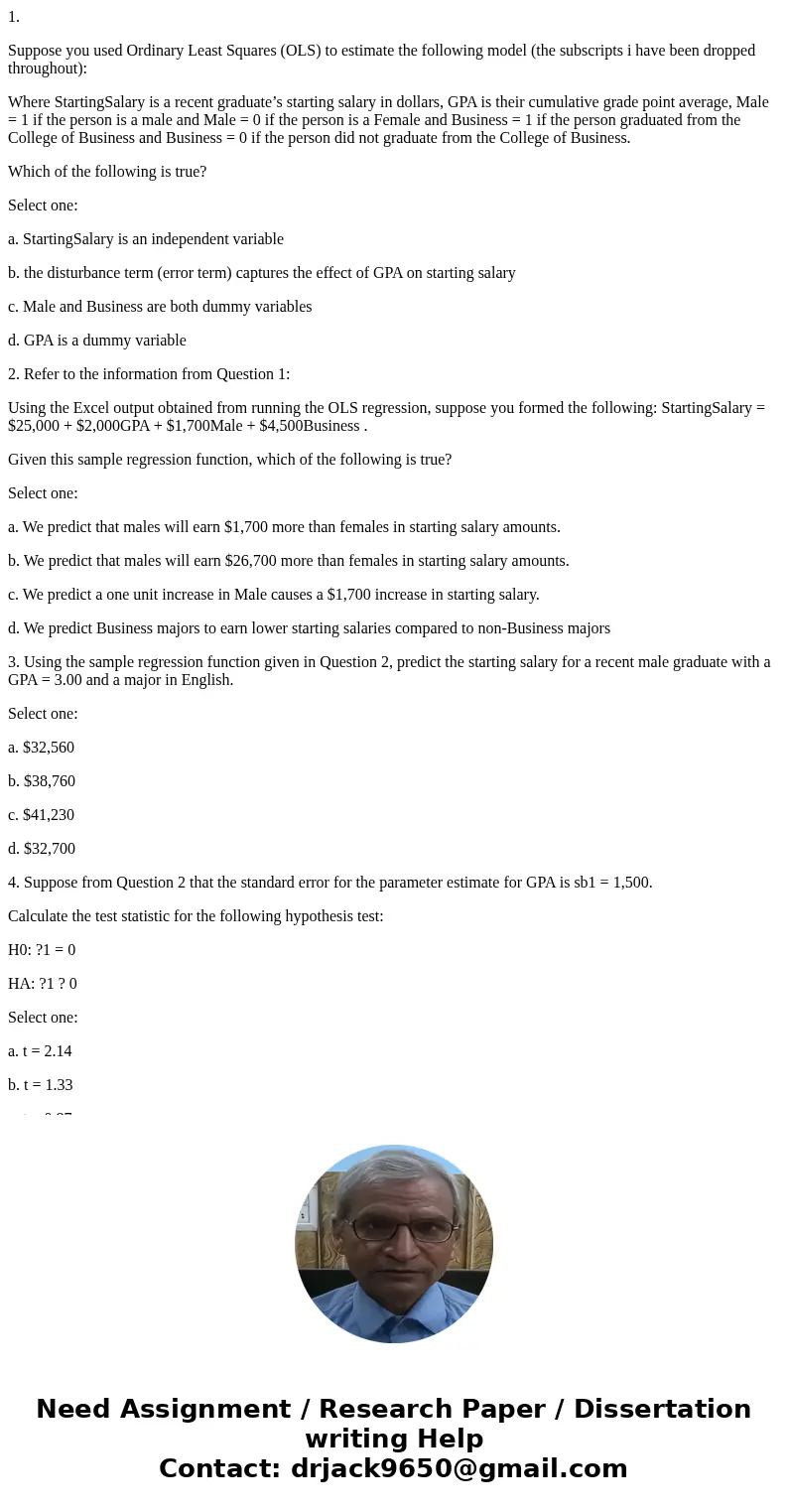
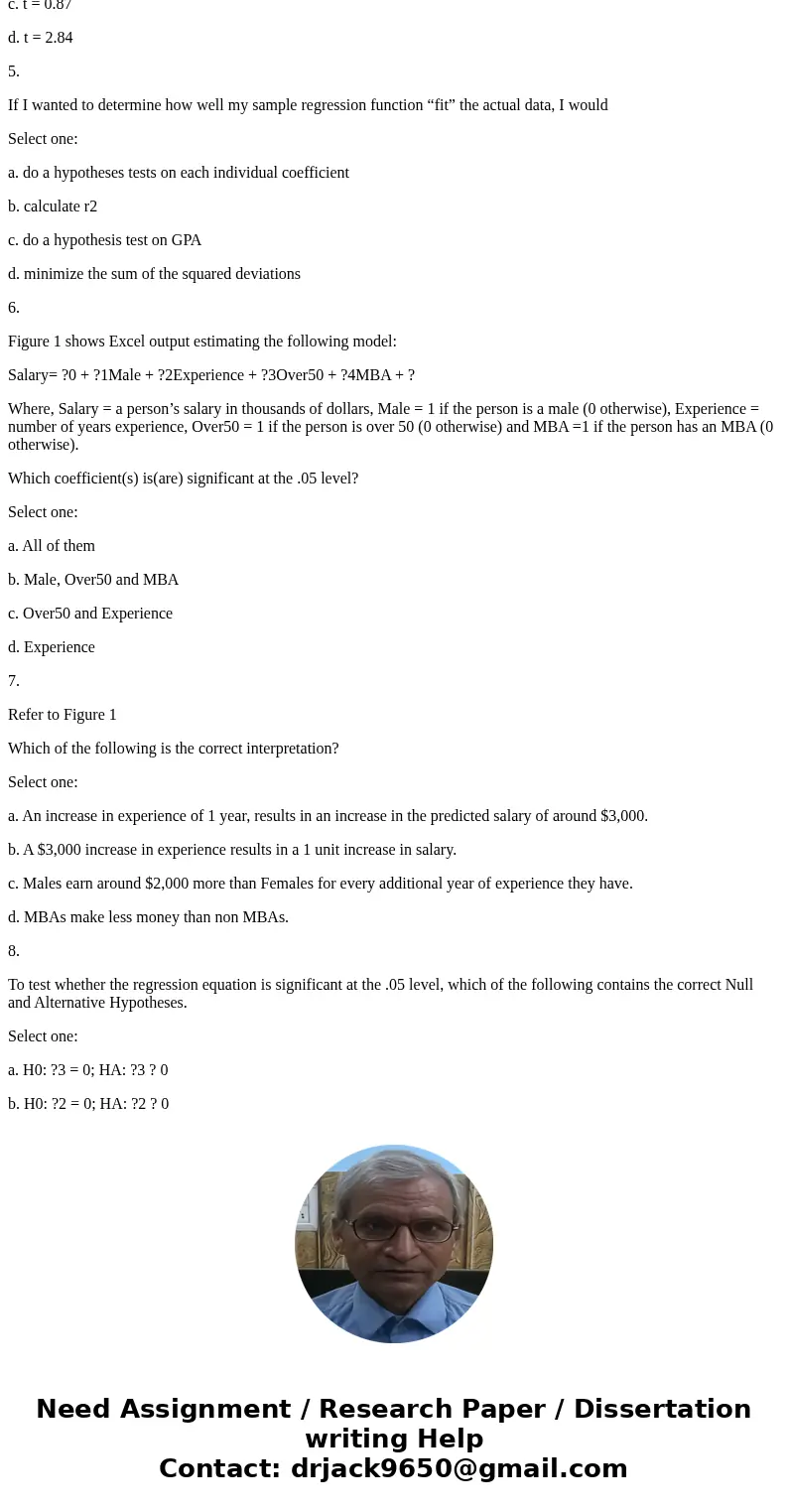
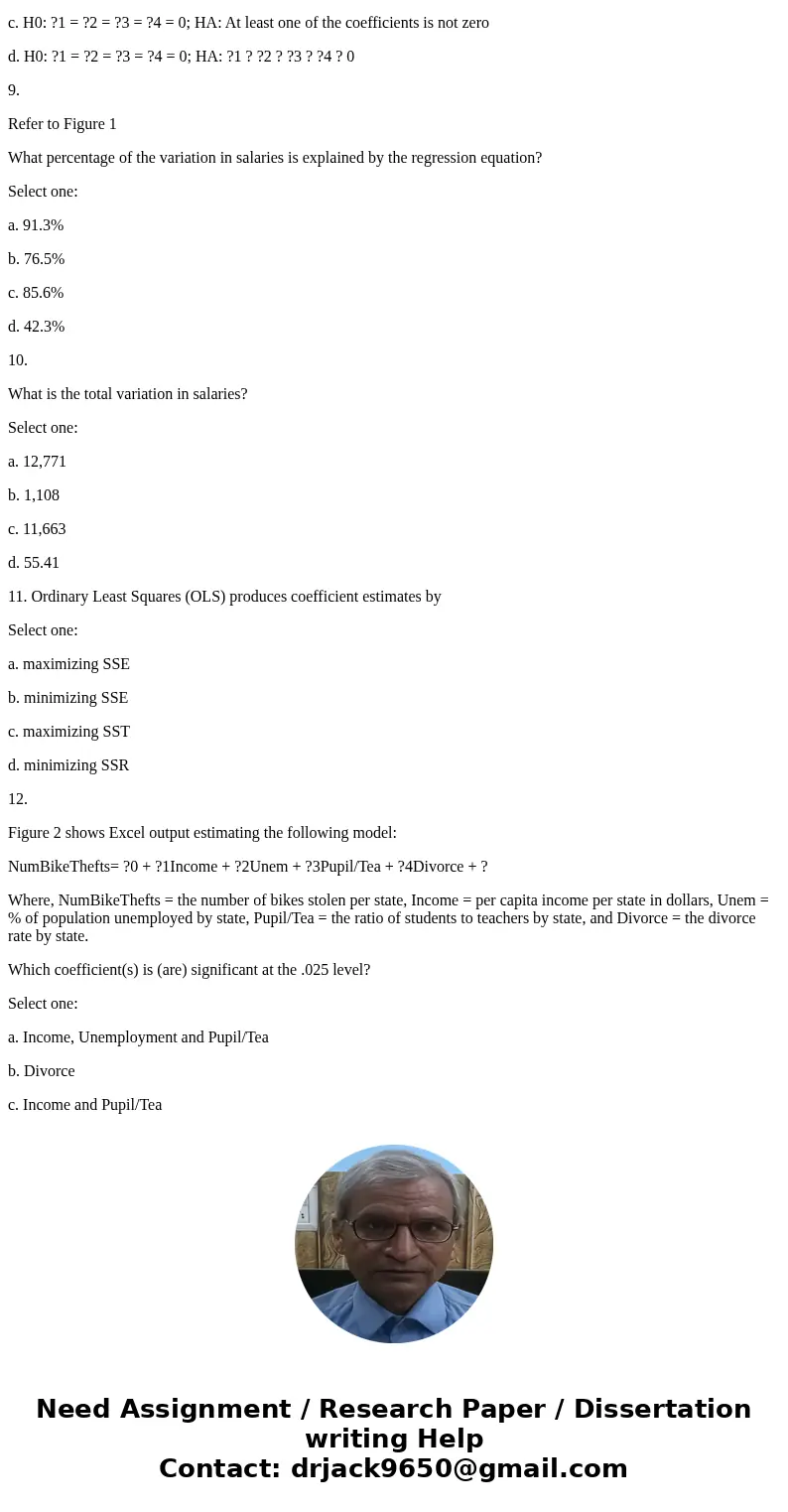
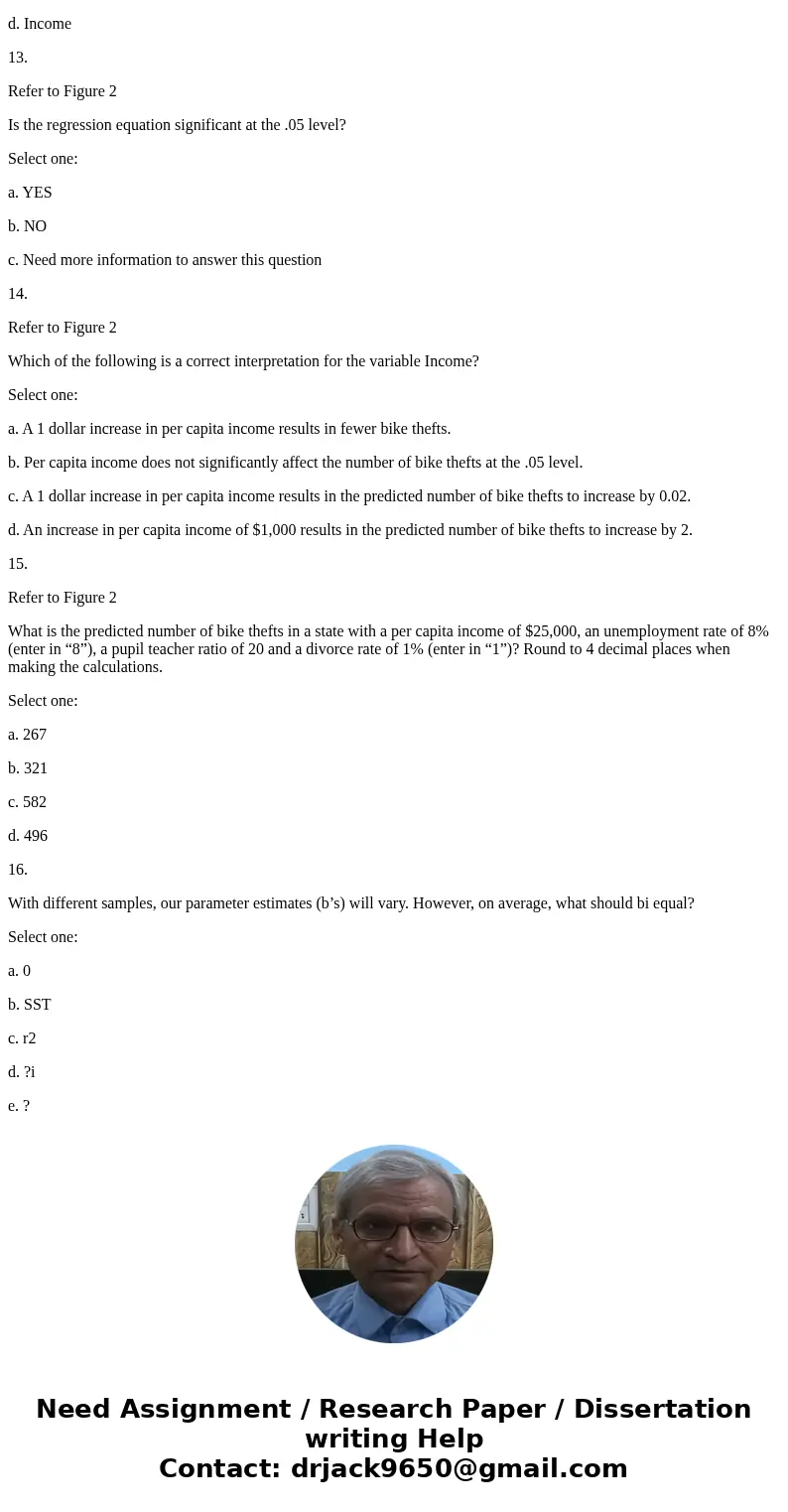
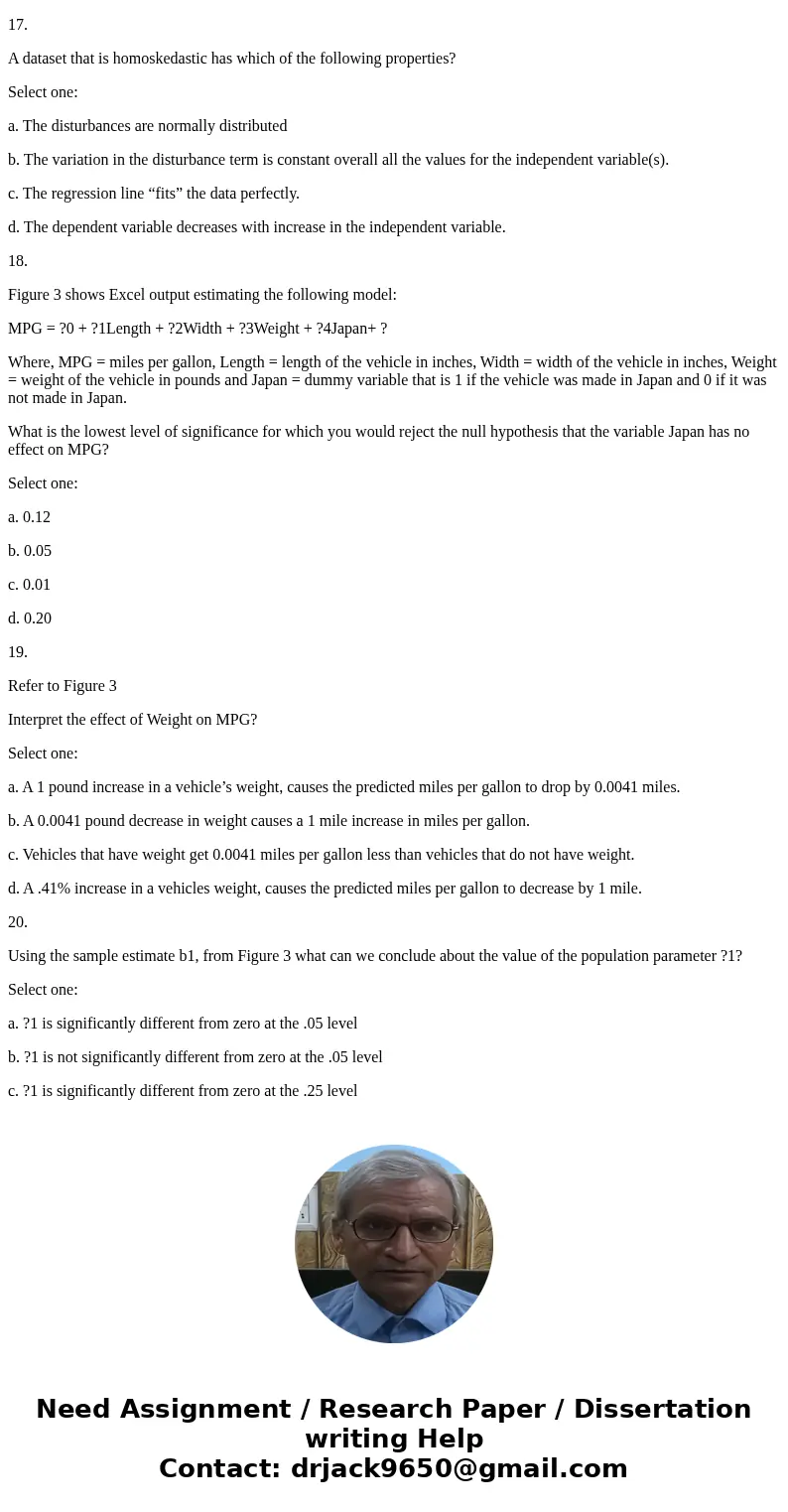
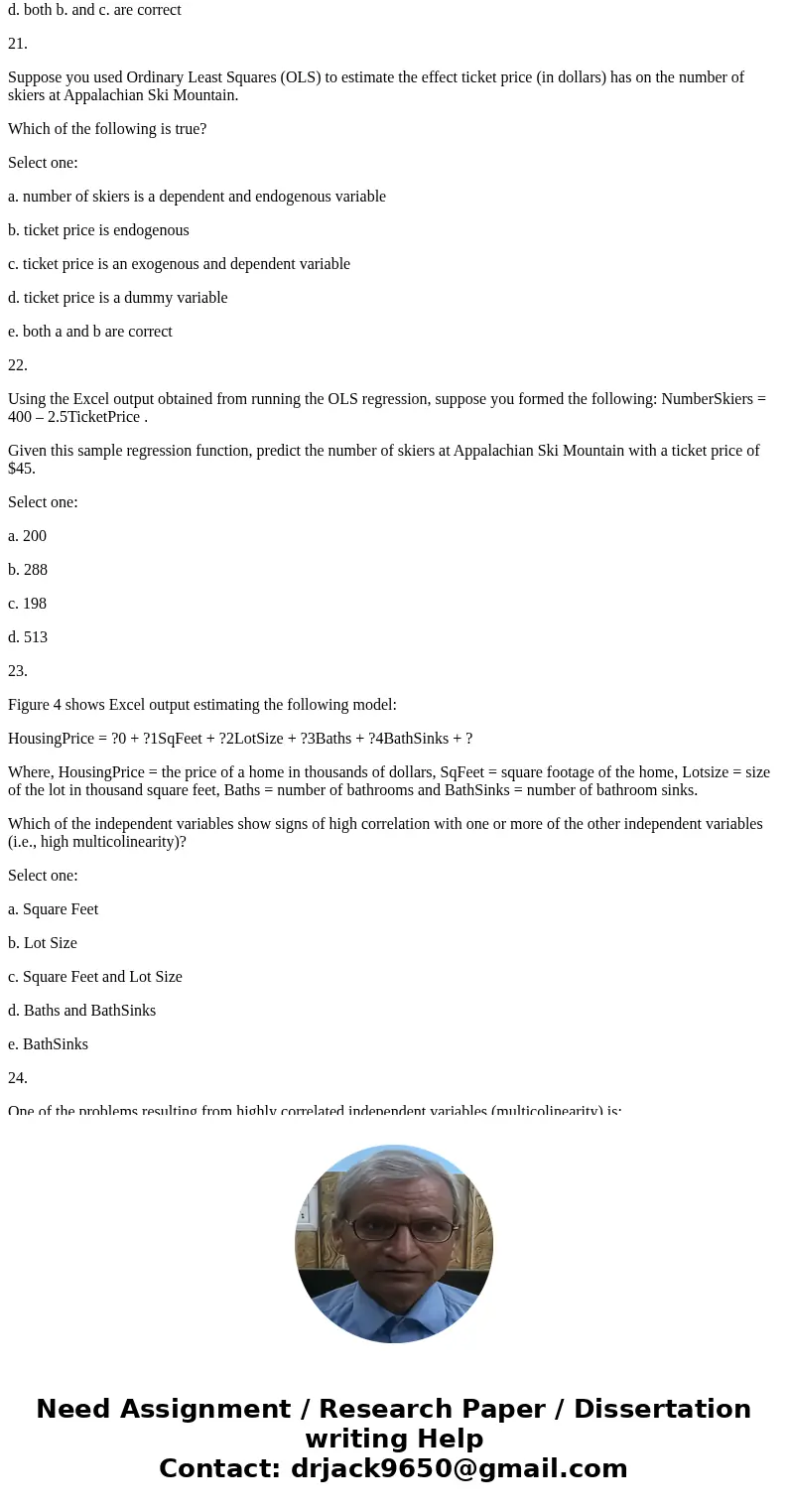
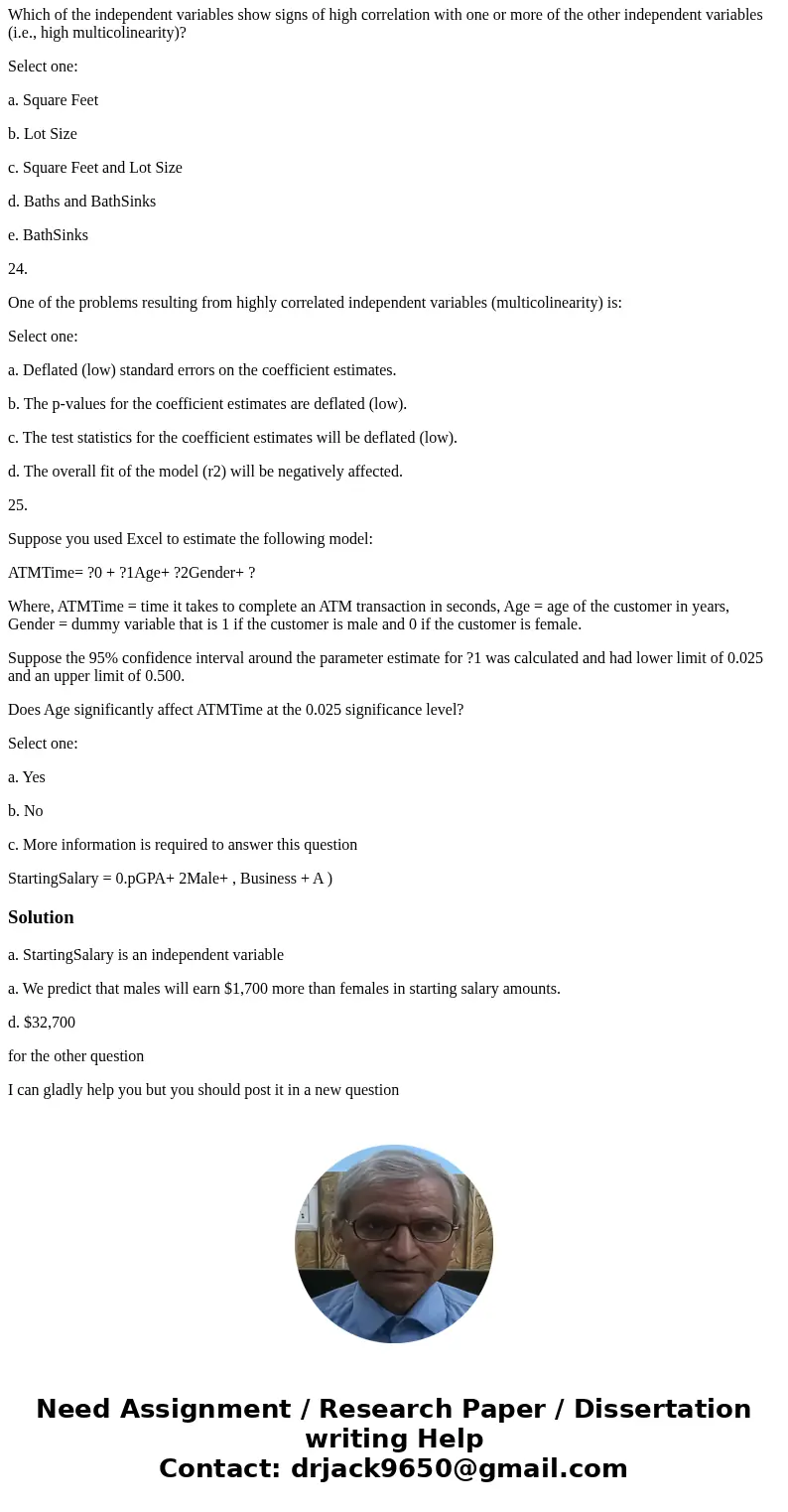
 Homework Sourse
Homework Sourse